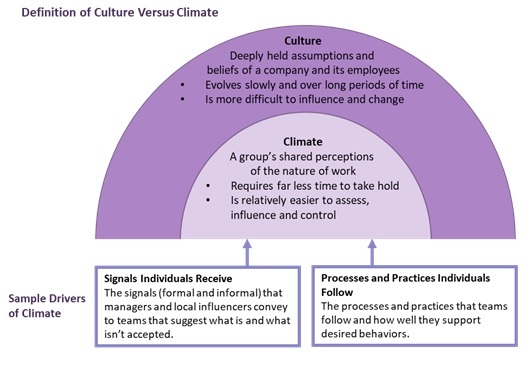- How to ensure focused attention of the cultural components of Metrics, Accountability, Transparency, Ethics, Diversity
- How company culture and climate impact compliance program effectiveness.
Did you know, that:
1 – Organizational culture and climate are two different ways of conceptualizing how people experience and describe their working environment.[1]
Organizational climate may be defined as: the way employees perceive and attach meaning to the policies, practices, and procedures of their organization and the behaviors they observe getting rewarded and that are supported and expected.
Organizational culture can be defined as: the basic assumptions, business principles values, and beliefs that characterize an organization, which are taught to newcomers and communicated internally and externally as the ‘right way’ to behave.

2 – A good climate can positively impact culture.
Often, we hear about the importance of the right ‘tone at the top’ and the ‘mood in the middle’. The management of a company should walk the talk. But it doesn’t stop there. Ethical leadership is required from managers in their relationship with their reports and there needs to be an adequate level of trust between employees. When employees work in strong climates, and experience ethical leadership and good behavior around them, these signals have a positive impact on their cultural perceptions. What an organization says needs to be in line with what an organisation does. A gap or even clash between the company cultural values and values on the factory/office floor, impacts how employees perceive their company’s culture of integrity.
3 – There are differences between a strong and a weak compliance climate.
A weak climate: The employee doesn’t feel true commitment of their organization for integrity and compliance. The communication and training focus solely on the consequences of bad behavior. There is no dialogue. Employees just try to stay out of trouble and follow the written rules. Positive behavior, such as speak up occur, but they are not visible or promoted.
A strong climate: Employees feel safe to address issues, ask questions and discuss dilemmas. They help each other to do the right thing and avoid misconduct. When cases of misconduct are reported they are investigated and dealt with. Positive behavior is promoted and rewarded. In the communication and training there is room for dialogue and reflection. Examples are provided on how compliance relates to the employee’s daily work and how to deal with them in a positive way.
4 – There are ways to reinforce a strong climate in your organization.
There are two main aspects to consider when building a strong climate:
- Be clear: Ambiguity is the enemy of integrity. Employees need to know what is expected of them. What behaviors do they need to exhibit? In what ways is their daily work impacted by integrity and compliance? When policies and procedures are inconsistent, the practices that emerge from them will likely be inconsistent as well, which will have a negative impact on the climate. Therefore, the practical implications of policies and procedures needs to be taken into consideration in the design phase.
- Line management needs help in conveying the message, as to avoid sending conflicting messages. There should be a dialogue between the management and employees about values and clashes between culture and climate should be discussed and addressed.
- Setting the right example: Instead of focusing solely on the consequences of misconduct and non-compliance, it is important to promote, praise and make positive behavior visible.
- Walking the talk: Also, in line with bullet 1, it should be clear for the employees that when they speak up and address issues, they are taken seriously, investigated, and appropriate action is taken, no matter the hierarchical position of the persons involved. Say what you do and do what you say.
5 – An organization’s strategy, values, climate and culture interact.[1]
The following conceptualization may help in explaining how an organization’s strategy, values, climate and culture interact.
Early on the climate of an organization is determined by the tactics that (at that time) prove effective to organization and what the leaders pay attention to and therefor allocate resources to.
Over time, when the organization is successful, the climate becomes embedded in the organization as set of implicit guidelines, values and basic assumption about performance, excellence, human relations, etc. So gradually they become the cultural identity of the organization. The organization will continue to evolve, new people will join, processes will change and there are external factors such as (geo)politics, changes in law and regulations, standards, etc.
Throughout these changes it is important to make sure strategy, values, climate and culture are aligned. Leadership and cooperation play a very important role. Research shows that there is a stronger climate when leadership is described as providing more and straightforward information, having a clear strategic vision for the work and having lass variable behavior patterns. Furthermore, climate improves when departments interact more, and are more interdependent.
The article is written by Claudia Sijstermans LLM, Head of Global Integrity & Compliance Operations, AkzoNobel.
Register here.
References
- Benjamin Schneider, Mark G. Ehrhart, and William H. Macey, “Organizational Climate and Culture”, Annual Review of Psychology, Vol. 64 (2012): 361-388.
- Brian K. Lee, Gartner 2018.

